[an error occurred while processing this directive]
Review of the Giant LaFree E-Bike
By Bryan A. Thompson
Last Updated 1/11/2002
Notes:
This review focuses on the Giant LaFree E-bike.
This is also marketed by Ford (in a slightly different configuration) as the
Think! Bike. The information below applies to three versions (folding,
non-folding and step-thru) of the LaFree and the Ford Think! Bikes. Giant
bicycles also markets another E-Bike called the Twist (in a comfort bike
configuration), which contains a different battery and motor. As a result, some
information in this review does not apply to the Giant Twist E-Bike. When I refer to the E-Bike or LaFree or EV, Iím
talking about any of the Giant or Ford Think bikes. Note also that there
are a couple of different models. The pictures and review presented here
are of the older style LaFree (battery indicators on the seatpost, not on the
columns).
My
Background
Iím
a 31 year old out-of-shape Electrical Engineer from the hilly town of Rolla,
MO. I graduated from and now work at the University of Missouri Ė Rolla. As a
student I worked on the first solar car project our school and drove GMís
SunRaycer in fall 1988 (for two whole laps around a smallish parking lot).
After that I became interested in personal computers and pretty much lost
interest in Electric Vehicle technology. That interest resurfaced on Sept 11,
2001.
Why I
chose an E-Bike
Most folks who come to EV technology do so out of concern for the environment.
Me not so much. When I drive, I drive a 13MPG V8 Corvette,
and then only because I canít afford a V10 or V12.
Recent attacks against my country culminating in the Sept. 11, 2001 tragedy have
revealed that the folks that sell Americans more oil than any other country also
sponsored (and largely provided) the terrorists responsible for those attacks.
That country is Saudi Arabia. Unfortunately, because of Americaís dependence
on oil, we have shown reluctance to pursue these terrorists into Saudi Arabia.
When I learned of the Saudiís sponsorship of the terrorists responsible for
killing close to 7000 Americans, I decided to do everything I could to keep as
much money out of their hands as possible. It may not be much, but Iíve reduced
my oil consumption by at least 40% - a level sustainable without Saudi oil.
Initial
Impressions of the LaFree
My
first impression of this e-bike is that the power assist is extremely well
designed and implemented. How does it work? You just pedal. The motor senses
the turning pedals and assists the rider in pedaling. You stop pedaling, and
the motor stops helping. You want more assistance? Just twist the throttle
(where the gear shift would be on the right side of the handlebars) and the
motor does more of the work. You want to ride without the motor helping? Just
turn off the power switch and you can pedal it like a fairly heavy normal bike.
When you apply the brakes, the motor automatically stops. The whole bike takes
less than two minutes to learn to ride, and maybe a half-hour to learn to ride
efficiently. The bike looks like something that Pee Wee Herman would be proud
to ride Ė it isnít the most stylish thing around. However the designers did a
great job of hiding all the wires and cables underneath the plastic motor and
frame covers.
Everyday
riding
I
ride about 4 miles a day total, all on quality paved road. At the end of
the day, the poor quality seat has taken its toll on my butt. Itís a whole
lot rougher ride than my Trek comfort bike (a Navigator 200). I attribute
this to the tires and low quality factory seat. If youíre planning on riding this
every day or for distances over a mile, plan on replacing the seat. The seat
post isnít the standard size (27.2mm), it's (29.2mm), so you need something
called a "Problem Solver" shim to adapt a regular seatpost to the larger tube
($7). See the "Upgrading" document for more info. Then when you do that, you lose the ability to tilt the seat
forward, so you have to remove the seat if you want to remove the battery.
I
have no problems making it to and from work with a fully charged and mostly worn
out battery. I donít recharge during the day. It sits in the cold (40+ deg F)
all day and still has plenty of power when I ride home at night.
I
donít have to do a lot of work during the commute, even when going up a hill
that would have forced me to walk a regular bike or puke my guts out half-way up
the hill. But the best part about the ride is that I still get a workout.
Others have mentioned it before and Iíll mention it here: The natural tendency
is to pedal the bike, even with the motor running constantly. Not just
pretend-pedaling, mind you Ė actually adding power to the pedals. I attribute
this as a desire on my part to get there quicker: To accelerate quicker, to go
up the hill 1MPH faster, and to do what I can to help the battery last longer.
Whatever the cause, I get more of a workout now than I did with my Trek comfort
bike. I live in a hilly area and am pretty far from being in any sort of
physical shape, and that combination just didnít work out. Iíd ride for 2-3
miles once a week, my legs would be so sore that I couldnít ride again for a
week, and I just didnít get out that often. Now I ride to work and get *some*
exercise every day Ė even if Iím not doing all the work myself.
As
far as the biking experience goes, it handles about like an uncomfortable
comfort bike. Itís heavy, so stopping is slow (it probably takes me another
20ft to stop from 18MPH). The handlebars are tall enough so that the ride is
pretty much upright. Thanks to the power assist, acceleration is quite good Ė
itís easy to jump into 25MPH traffic. Above 35MPH (back down that big hill in
the evenings) it was quite scary until I had both wheels balanced. It still
isnít fun. I started wearing a helmet because of the weird feeling I get on
this bike when riding over 35MPH.
It
is heavy. If you live or work somewhere where you need to carry the bike up
stairs, get a different lighter bike. I go up and down one 1ft stair to and
from my apartment and it sucks. The bike can be made lighter by removing the
battery, but thatís a nuisance, so I donít do it. Instead I deadlift a rather
awkward 70 pound weight and try to maneuver handlebars through a front door that
doesnít want to stay open.
How much
power does it really have?
The
web site claims 400W continuous and 1000W peak. That translates into about .54
HP continuous and 1.34 HP peak. But how much power is that really?
I
had no idea how powerful this thing was before buying one, and so I didnít
really know what to expect. I live *way* downhill from work (1.5 miles on
a 5+ percent grade) and wanted help getting up the hill in the morning. I
weigh 275lbs. This bike will pull me up that 1.5 mile hill with me in
pretend-pedal mode at about 8 MPH. The bike slows to about 6MPH on a
section thatís roughly 10 percent grade, but it still pulls me without me having
to do any work. The bike accelerates fairly quickly. On flat ground,
5-6 revolutions of the pedals is all it takes to accelerate to top (motor
assisted) speed of 18 MPH.
I
understand that itís possible to swap out the rear gears for something that will
provide an even lower gear ratio, allowing for more pulling power (at a slower
speed, of course). This might be useful if youíre towing something, but I think
itís probably unnecessary otherwise.
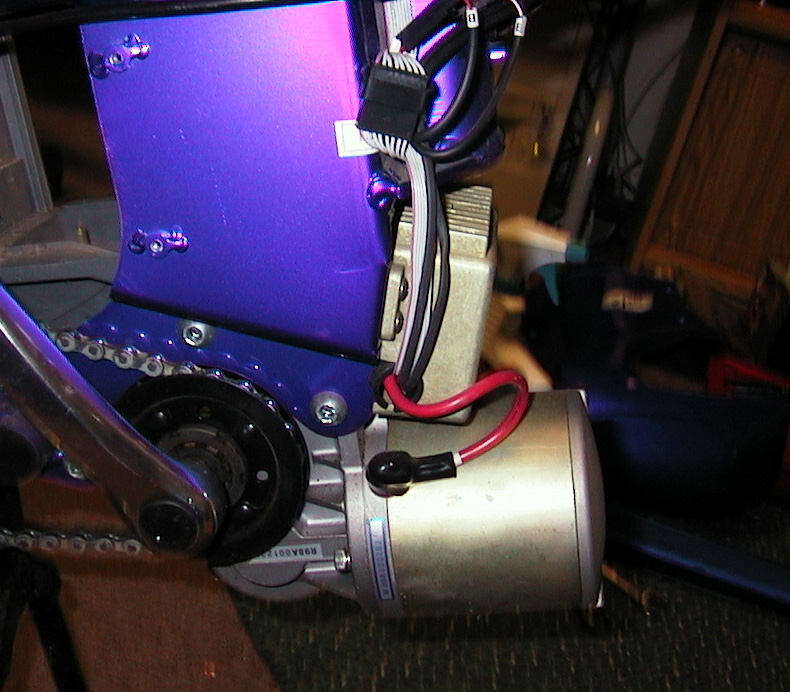
Closeup of the motor and front sprocket
The
Throttle (VPC)
The
throttle is located on the right-hand side of the handlebars and is
twist-activated instead of thumb-activated. Iíll start by saying that it isnít
necessary to use this at all. You can just pedal and still get a motor assist.
Without turning the throttle, the motor runs full speed for about 0.5 seconds
(which translates to about Ĺ of a revolution of the pedals). If you want it to
give more of a power assist, twist the throttle (called the VPC, or Variable
Power Control by Giant/LaFree). This causes the motor run duration to increase
(up to 2-3 seconds at a time). If after that time youíre still pedaling,
whether youíre pedaling hard or just causing the pedals to revolve, the motor
will continue to run. If you continue to pedal, the motor assist stays on and
the power feels quite smooth. The motor will stop after the 0.5s Ė 3s bursts
if you stop pedaling.
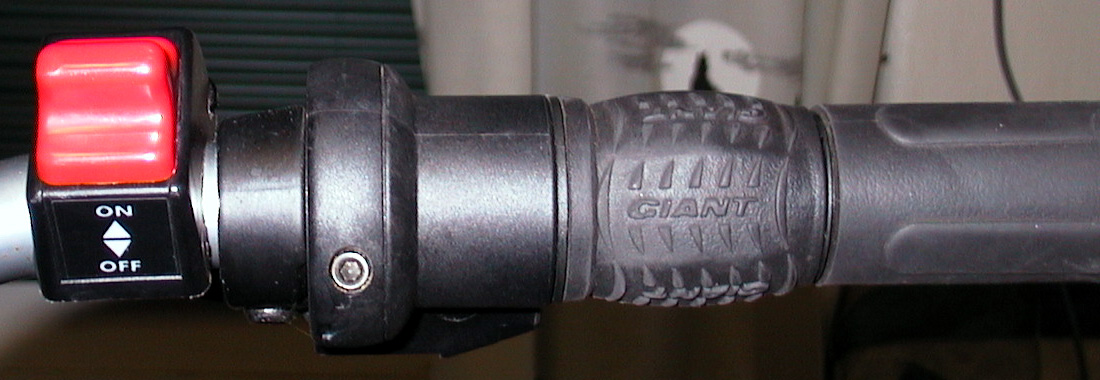
The
Throttle and On/Off switch
Shifting
The
bike has a 7 speed gear system built-in, and the motor powers the front sprocket
(it doesnít move the pedals, however). This means that the motor works through
the gear system. If Iím going up a long hill, I select low and it has plenty of
power at about 6-8MPH tops. In 7th gear, it tops out at about
18-20MPH. The best part about the shifting mechanism is that unlike most
multi-speed bikes, it will shift while under load (like going up a hill). On a
regular bike, you either need to anticipate gear shift changes well in advance
or youíre stuck in the wrong gear when going up a hill. With this system, I
listen to the motor RPM, and when it sounds loaded down, I twist the grip and
shift into a lower gear. This works whether the motor is busy pulling me up a
hill or if Iím just coasting. This is really well designed. No problems
starting in the wrong gear here Ė on level ground I can start off in any gear.
Acceleration is not much in 7th gear, but can be assisted via the
pedals.
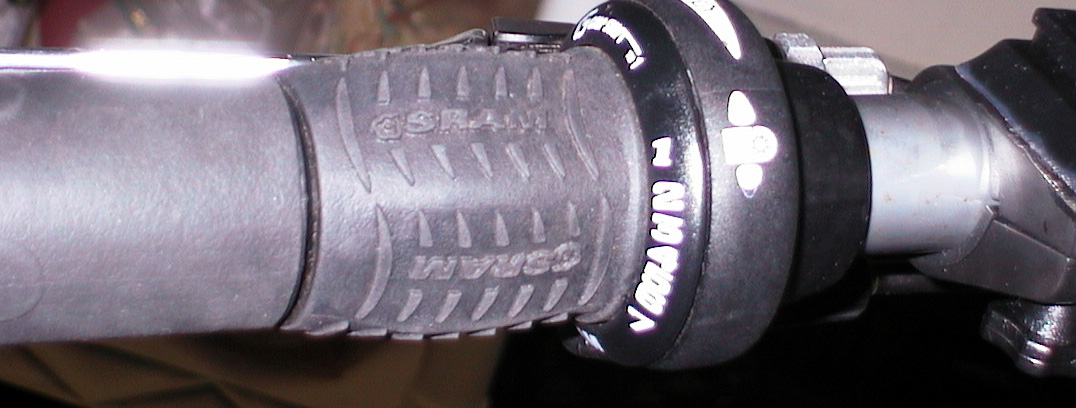
The Shifter
Security
The
LaFree comes with a built-in ignition key lock. The lock retains the battery
pack and acts as an on/off switch for the bike. Unfortunately this is all
housed in some cheap plastic and doesnít really provide any security other than
keeping the bike and battery together. Any kid with a screwdriver could crack
the plastic and easily hotwire the bike.
The
bike also comes with a front wheel U-lock that uses the same key as the
ignition. This seems like a great idea, but in practice, it is difficult to
weave the u-lock between both sets of spokes and still get the ends of the U
lock to line up with the holes in the lock mechanism. The result is that the
paint on the front forks is chipping pretty bad and I get grease on my fingers
every time I use the lock. It would not be an ideal situation for a businessman
commuting to work.
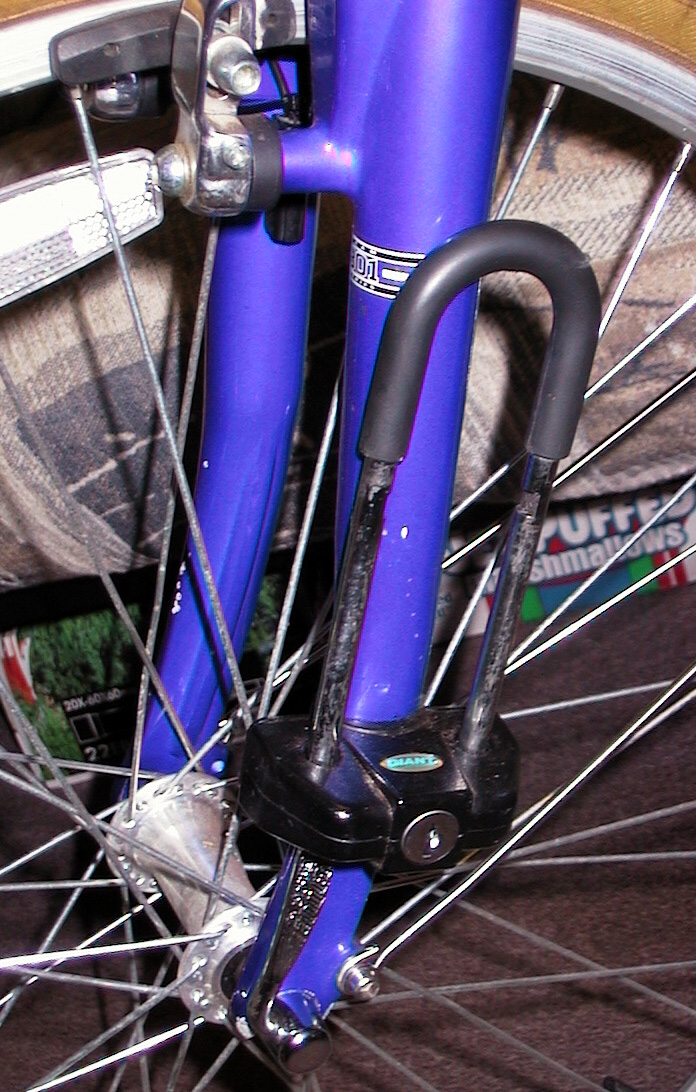
The
U-Lock
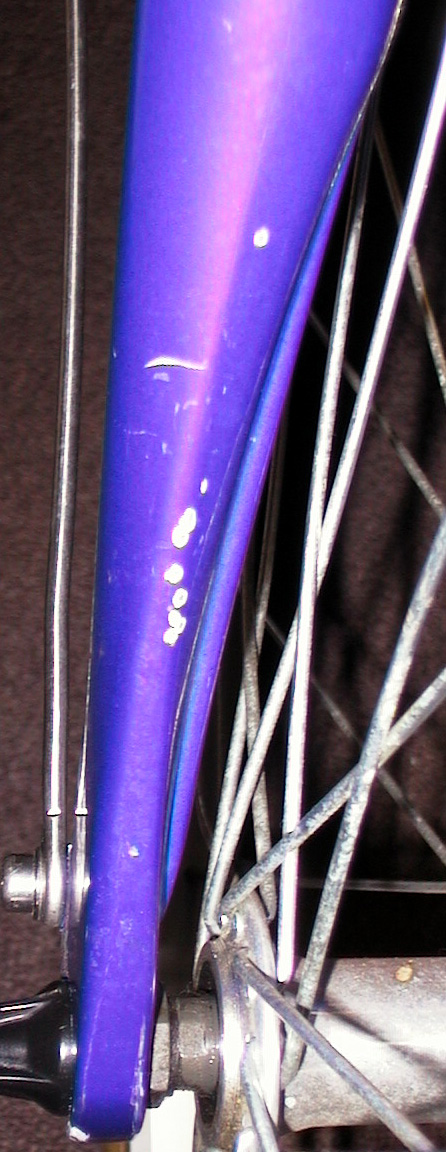
Paint chips from the U-Lock
Both wheels have quick releases, which means you need something to hold the rear
wheel on the bike. Although itís heavy (70lbs), someone could pick it up and
carry it off a short distance, so I think itís a good idea to lock it to
something (tree, bike rack, etc). I use a 3ft cable lock to accomplish both.
It coils around the seat post when Iím riding.
One
thing that Iíve noticed is that the seat also has a quick release/adjust and no
way to secure it to the bike. If someone wanted to steal my seat, itíd take
them about 2 seconds to do so.
Noise
Some folks claim their E-Bikes are silent except for the tire noise. Not so
much here. The motor noise is about the same as an electric golf cart Ė a
slight whir. Not very loud, but enough to remind me that itís not me doing all
that work. It growls about like my dachshund when pulling me up a 10% grade.
Braking
The
brakes grab unless theyíre new Ė use them sparingly. I use the rear brake
exclusively after seeing my friend flip over the handlebars of my LaFree
stopping from about 5MPH when he locked up the front brakes. The flip wasnít
too bad, but the LaFree came down and did a Gillooli on his knee. The bike was
uninjured.
Gearing
The
front sprocket is really small (21T). The rear sprocket is the same size as
most 7 speed rear gears. At first I thought the gearing would be extremely low,
but it turns out that the front sprocket and pedals are connected through the
gearbox. One turn of the pedals results in 3 turns of the sprocket, making it
in effect a 63T front gear.
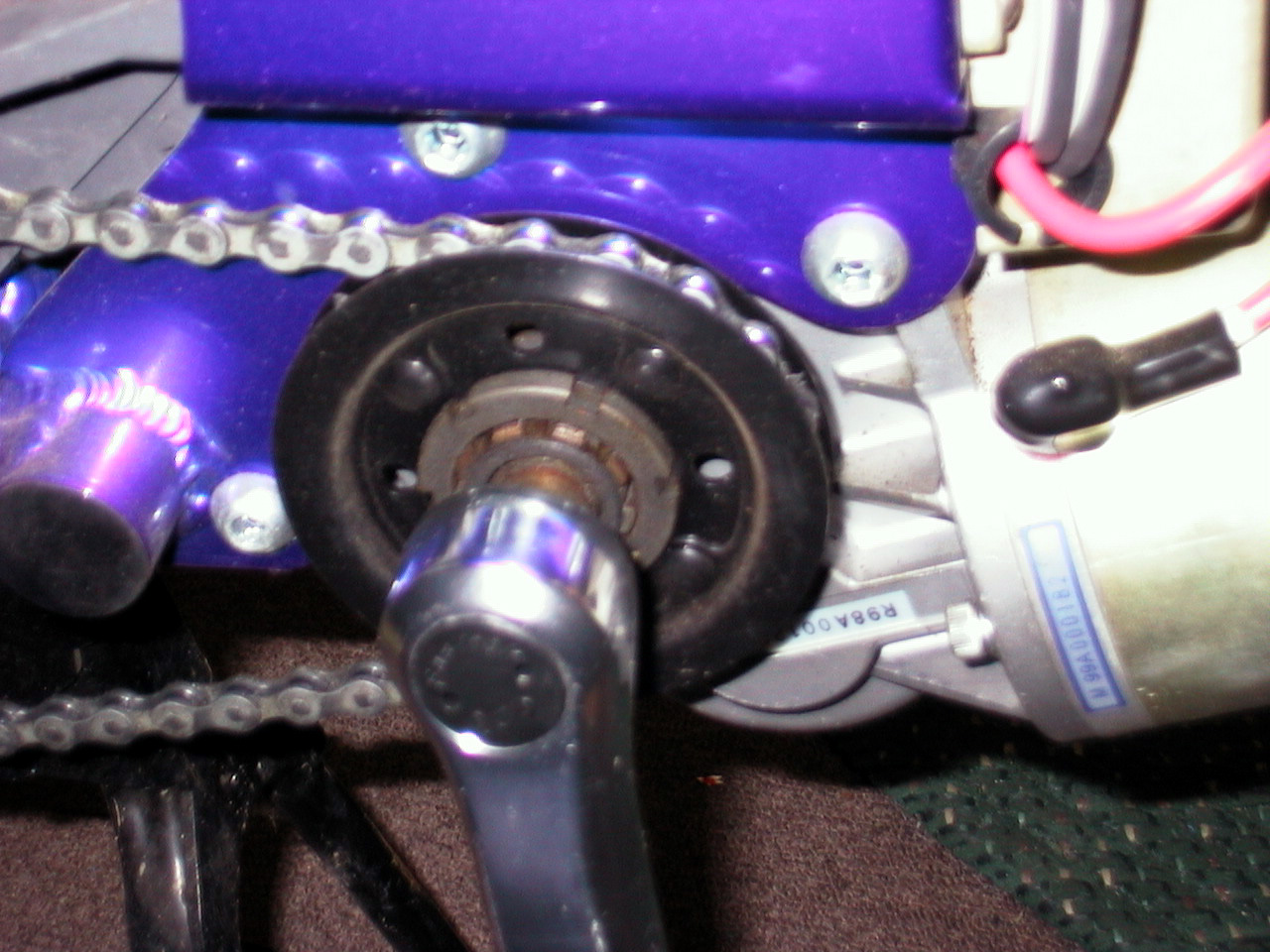
Closeup of Sprocket
Gear selection isnít nearly as critical as it is when the rider is providing all
the power. The motor has a fairly constant torque output no matter what its
speed. So if you start off in a high gear, acceleration is less than it would
be in the lower gear, but the bike still goes forward. Iím sure that battery
economy suffers from this, so I recommend starting in lower gears and working
through them as the bike accelerates.
Itís possible to start off in 7th gear and accelerate to full speed
fairly quickly. However I like the feeling of better acceleration, so I usually
start in 5th gear and shift to 7th after I get going.
When going up hill, I shift to 2nd. If the motor still sounds bogged
down, I shift to 1st.
Weather
Nothing appears to be too well sealed in this thing. Even though the factory
claims theyíre OK for the rain, I wonít ride in the rain. The motor and
electronics probably shielded from the weather well enough to ride on wet
pavement after rain. Donít try driving through a foot-deep low water crossing
(theyíre common around here).
I
average faster speeds than I do on my non-e-bike, and during the winter (I ride
when dry and above +40 degrees F), I find myself getting colder faster.
Range
Iíve seen 24-25 Miles advertised, but I assume thatís with quite a bit of
pedaling and on flat ground and minimal starts and stops and a 150 pound rider
and probably a 20MPH tail wind. 288 Watt Hours just isnít that much power.
Others that own them say 15 miles. I assume theyíre doing some pedaling, too.
My
experience (with the known-to-be-dead three year old pack that came with my bike
when I bought it used) is that it lasts about 4-5 miles, 1.5 miles of which is
mostly pulling my 275 pound ass up a 5-10%, 1.5 mile long hill.
The
range can be extended by doing the following things: Pedaling (not just making
the pedals go around, but actually doing some of the work), riding on flat
ground, raising the air pressure in the tires to 65-70 psi (which makes it less
comfortable to ride), crouching instead of riding upright, switching to low gear
before starting uphill, riding in temperatures around 70 degrees F (hotter or
colder decreases battery capacity), replacing 1 + year old batteries with new
ones, and minimizing the total weight of rider, bike and cargo.
Iíll report more when I have replaced my batteries with a fresh pack.
Speed
Max speed on flat
ground without pedal assist is 18MPH. The motor drives through the gears,
and experience shows that it goes about 6MPH in first gear, 8MPH in
second, etc, up to 18MPH in 7th gear.
Speed up hills
depends on the hill. It slows to 13MPH on a 3% hill, 8MPH on a 5% hill,
and 6MPH on a 10% hill.
Riding on Hills
Since the motor
turns the front sprocket, the motor drives through the gear system - 7 speeds.
This means that it has the ability to climb incredibly steep hills (manual says
14% grade max) and still have a decent top speed (18MPH).
Speed up hills
depends on the hill. It slows to 13MPH on a 3% hill, 8MPH on a 5% hill,
and 6MPH on a 10% hill.
Riding
Tips
Before loaning it to your friends so that they can see how cool it is, ask if
they know how to ride a bike.
When climbing hills, use 1st or 2nd gear. It wonít go any
faster in a higher gear, and using the lower gears minimizes the current draw on
the battery. Itís also easier to help the bike up the hill when itís in a lower
gear.
It
isnít a mountain bike Ė donít try to ride it like one. Even rolling off a curb
gives bike and rider a tremendous jolt due to the weight of the bike. These
suckers are made for smooth paved roads.
Keep the tire pressure at 65-70 psi. This helps reduce rolling resistance,
making it easier to pedal and easier for the motor to power. This doesnít help
the ride.
Dangers of starting on a hill: Positioning the pedals when stopped is
different than on a regular bike. When stopping, I usually roll back to get
the pedal in position for me to power my way out into traffic. This doesnít
work with the LaFree Ė in fact, rolling backward causes the torque sensor to
think that Iím trying to pedal (even if Iím not turning the pedals), and
activates the motor (sending me out into traffic before I expected to start).
The same behavior happens when I stop on a hill steep enough to cause the bike
to roll backward. Applying brakes overrides the motor drive, so I always
apply brakes until the last second before I want to start.
Buying used
There are a few things you need to know when purchasing a used LaFree.
These are things that I learned the hard way. I list them here so that
maybe you wonít have to.
- The battery will probably need to be
replaced. They last about 1 - 1.5 years if used to commute to work several
miles per day. Replacement battery packs (the things inside the gray
energy cell housing) cost about $25 each, and there are two in the housing ($50 total). Even if the
battery level indicates a full charge, worn out packs can drop to 0 power very
quickly (in 50 ft of riding). See the battery section for more info. My point
here is that if you donít confirm that the battery is good by riding it through
an entire discharge cycle, expect to replace the batteries.
- The bike likely needs new brake pads and cables.
Theyíre really heavy (~70-80 pounds). Maybe thatís why they need brakes so
often. Maybe itís the higher average velocities that causes it.
- Almost no one bids on these things on EBay. Theyíre
available new in box for about half list price. This method would be much
preferable to buying used.
- Be prepared for paint chips. Paint chips easily on
Aluminum frame bikes, including these.
- If price is no problem and you want more power,
check into one of the EV Global 36V SX bikes (about $1500 new despite the ďfrom
$1895Ē claim on the website). Theyíve got about 25% more power than the Giant
LaFree bikes and look cooler, too.
Summary
This is a
great bike and Iíd buy one again in a minute. ok like a danged idiot to those
around me, but by commuting via E-Bike, Iím keeping at least $500/yr out of the
hands of the Saudis.
[an error occurred while processing this directive]





